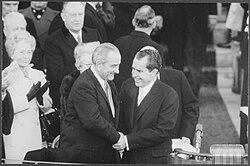 Richard Nixon takes the oath of office as the 37th president of the United States | |
| Date | January 20, 1969 |
|---|---|
| Location | United States Capitol, Washington, D.C. |
| Organized by | Joint Congressional Committee on Inaugural Ceremonies |
| Participants | Richard Nixon 37th president of the United States — Assuming office Earl Warren Chief Justice of the United States — Administering oath Spiro Agnew 39th vice president of the United States — Assuming office Everett Dirksen United States Senate minority leader — Administering oath |
| ||
|---|---|---|
Personal U.S. Representative from California U.S. Senator from California 36th Vice President of the United States
Post-vice presidency 37th President of the United States
Appointments Policies Tenure
Post-presidency Presidential campaigns Vice presidential campaigns
 | ||
The first inauguration of Richard Nixon as the 37th president of the United States was held on Monday, January 20, 1969, at the East Portico of the United States Capitol in Washington, D.C. This was the 46th inauguration and marked the commencement of the first and eventually only full term of both Richard Nixon as president and Spiro Agnew as vice president. Chief Justice Earl Warren administered the presidential oath of office to Nixon, and Senate Minority Leader Everett Dirksen administered the vice presidential oath to Agnew. [1] [2] Nixon had narrowly defeated Hubert Humphrey, the incumbent vice president, in the presidential election. Nixon became the first non-incumbent vice president to be inaugurated as president, something that would not happen again until Joe Biden in 2021. This was also the last presidential oath administered by Chief Justice Earl Warren. It was the last time until 2025 that Hail, Columbia wasn't played for the new vice president immediately upon taking the oath.


